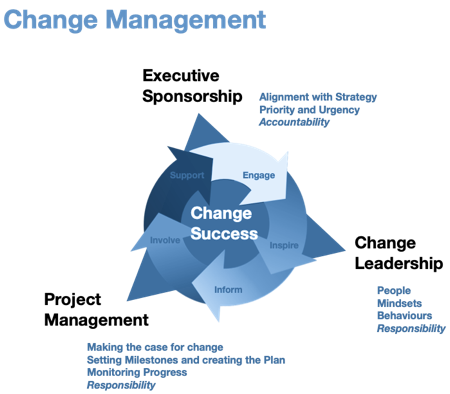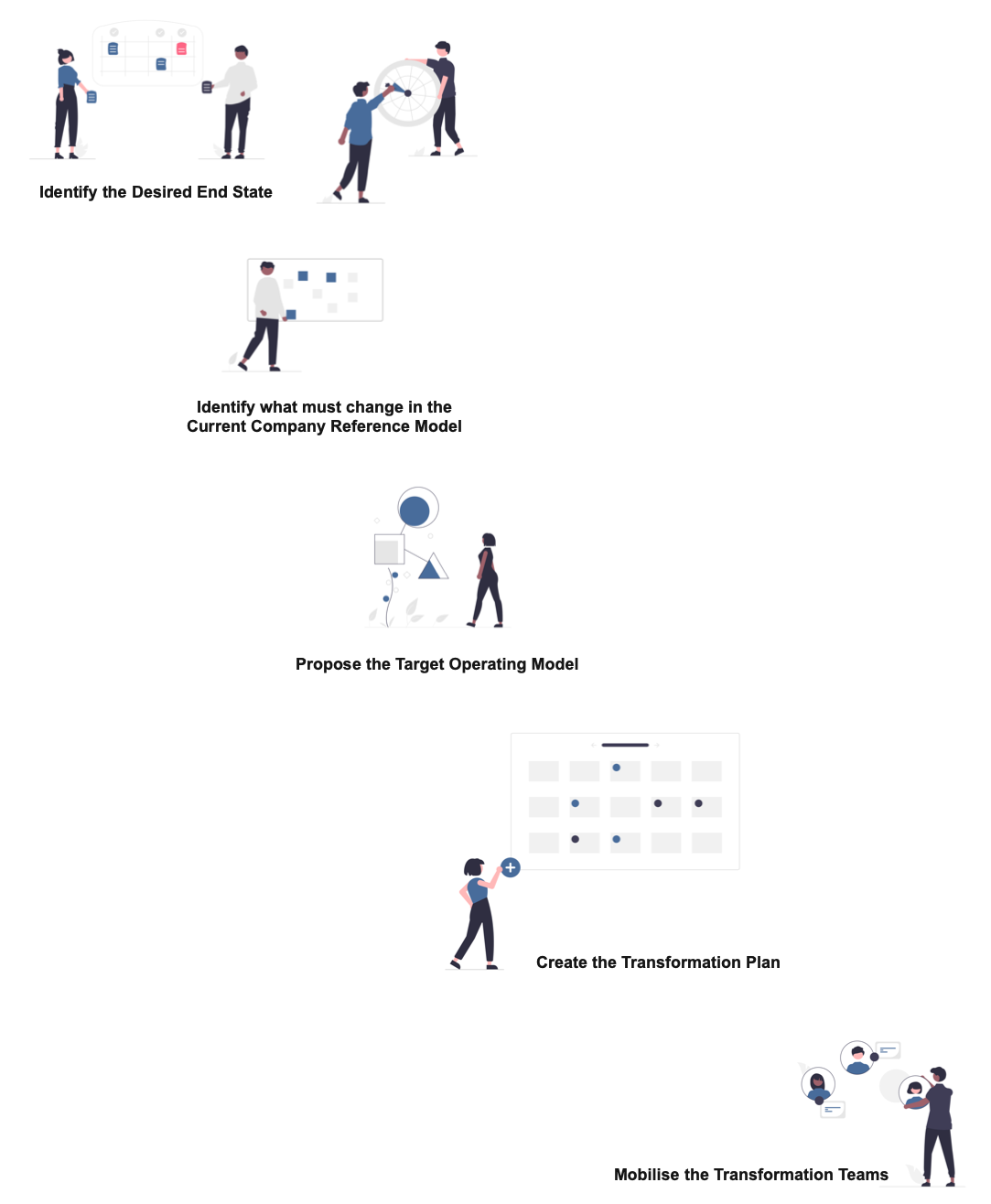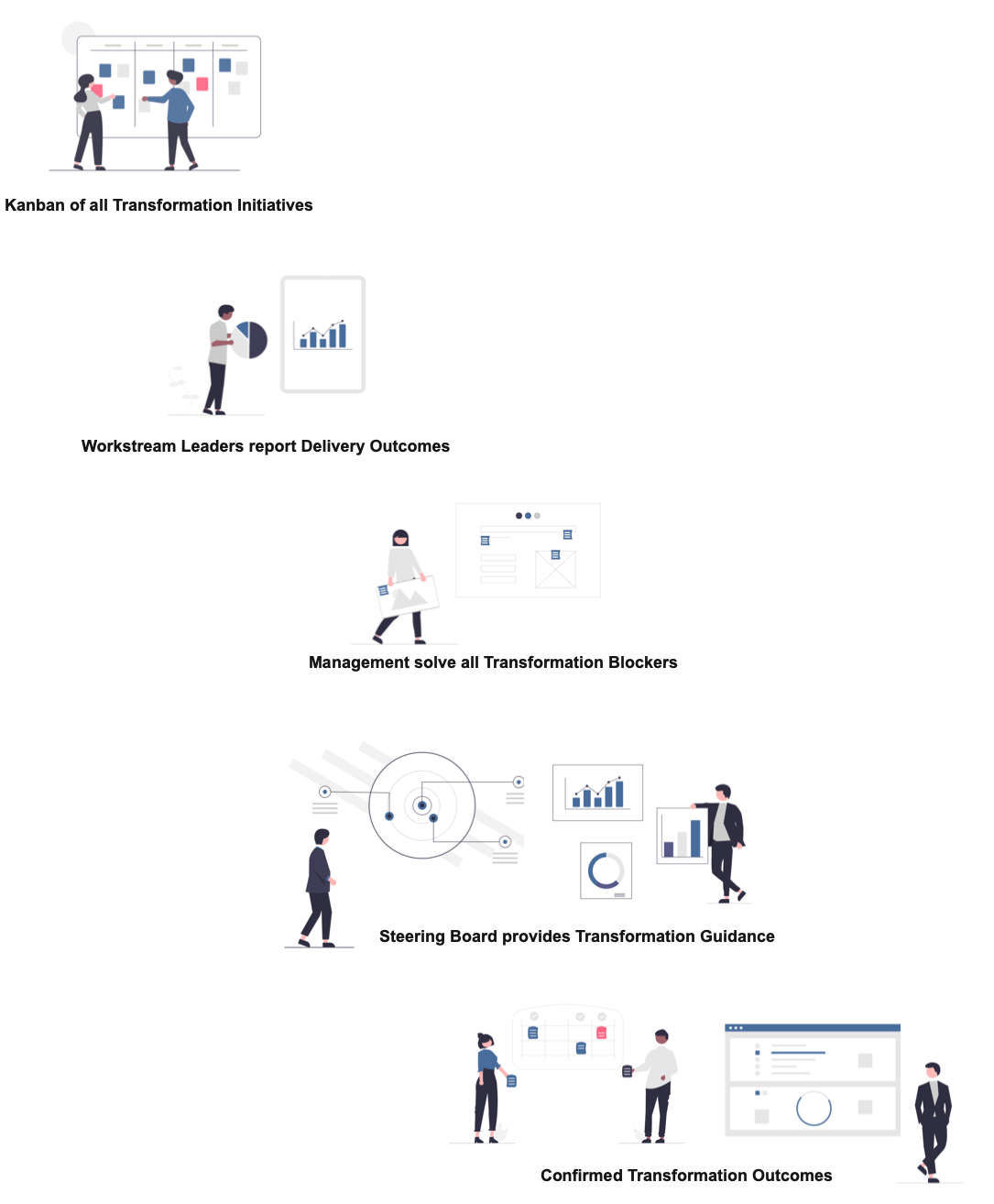The terms change and transformation are used interchangeably by many. Whilst both are related, there are some important differences. Change is concerned with making well defined, bounded and finite adjustments - a visible and measurable shift in how a particular aspect of an organisation functions. Transformation is concerned with changing the whole organisation, a much more far-reaching endeavour concerned with the very way it does business.
If Change is about improving a particular part of a business, then Transformation is about renewing the whole company.
For example, a Change initiative might be to introduce a new customer experience system to better allow the capture and resolution of customer concerns. A Transformation might encompass a decision to become a truly customer-centric organisation, which involves transitioning to a new operating structure, training in desired new behaviours, the introduction of specific tooling and/or a revised product set.
Change initiatives are relatively easy to identify, define and implement - they have a beginning, middle and end, and can be managed as a programme of work.
Transformations seek to reposition the organisation as a whole, tend to require invention or discovery of new value on the path to the future, and require the execution of several intersecting and interdependent initiatives. The extent to which these initiatives contribute to the necessary shift in focus and performance is less obvious to many. As such, Transformation can be seen as more risky and unpredictable, and harder to create a case for investment.
Change initiatives may be part of an overall Transformation, but not vice versa. Successive changes could be successful, but the transformation may still fail. Many do. Change is concerned with altering embedded ways of working. Transformation is about the profound modification of core beliefs and behaviours, over the long-term.
All transformations require a rethink of how the company creates value today and may do so in the future. Incremental improvement is not sufficient in the constantly disrupted business environment of the present day. Companies must embrace agile reinvention to win tomorrow. This requires senior leadership to think big, to make the strategic decisions that affect organisational operation, growth and profit.
The major part of any change initiative is the response of the staff to the change. Therefore, most of the effort of each change initiative is focused on the people affected by it, and their journey to accept and embrace change. There are several well-known Change Models which encapsulate best-practice for delivering long-term change success, notably PROSCI's ADKAR Model for Change Management, McKinsey's 7-S Model and Kotter’s 8-Step Change Model.
Change success is largely about the softer-outcomes - culture, conflict and communication. Transformation success is largely about the ruthless delivery of value.
The broad concepts of Change Management are discussed below, followed by a commentary on an approach to Transformation.
Change Management
The term 'change' is perhaps more often referred to as 'change management', an organisational discipline which has been recognised for 3 or 4 decades, and spoken about for much longer.
It is helpful to review how companies have evolved, to better understand how thinking as to how change is managed has progressed.
Machines. Many early companies used machines to make new products for new markets, or to make existing ways of working more efficient. Companies were an extension of that process. Change was viewed in the same mechanical cogs and wheels manner - a mechanical way of working.
Hierarchies. As various companies merged and organisational size grew, the concept of functional capability meant that businesses were organised into hierarchies of people with similar skill sets. Change management tended to focus on organisational structure.
Collections of People. As the 21st century dawned, leaders began to put more value on the people in their organisation. Their companies were not just organisational structures, or machines to be switched on or off. Change management theory moved onto leadership, behaviours and experiences.
Embedded Agility. Successful companies now organise for customer-centricity, with full recognition of the need for the organisation to be able to respond quickly, and to stay relevant as markets, customers and technology evolve. Agility includes having the right mindset and tooling to be ready for the inevitable change; and having positions within the organisation to facilitate such change.
A transformation initiative will deliver the embedded agility that the organisation must now achieve. Ongoing change then happens within it.
What is Change Management?
Fairly obviously, it’s the management of change - usually within a scope boundary, such as a team, group, department or company.
Change Management is a collective term for all ways of preparing, supporting and making change stick - be it change to people, process or tooling. Regardless of which change management model is used the prime focus is always on the individual. There are 10 important steps to follow:
- Set out a Vision. People can't get behind something that they don't know about or can't understand. Explain who will be impacted and why the change is needed. This vision is often contained within an overall Transformation Strategy.
- Explain the Benefits. Paint a metaphorical picture of the sunlit uplands after the change, and of what the benefits will be - both to the individual as well as for the company.
- Create a sense of Urgency. The human condition does not enjoy change, so those impacted need clarity on why change must happen, and must happen now. The proposed change must be be seen as relevant to each person who will be affected by it.
- Check Readiness. Every change has an optimal time frame for action, and some changes need enabling actions to either start or finish. Make sure that the systems, data and organisation are in a fit state, ready for the starting gun to be fired. Readiness includes the willingness and ability of people within an organisation to adapt to a change. Perform Root Cause Analysis as needed, and mitigate the findings to increase chances of success.
- Commit Resources. People will be busy with their day jobs, so need to know what their contribution might be, and who else will be involved. It is vital to have proactive executive sponsorship, and an implementation team who have the time to commit to the activities needed. Successful organisations have trained Change Agents embedded in operational teams, and make allowances for individuals to take time out to master the effect of change.
- Consider Blockers. Think about the current change load and possible change fatigue. Assess if middle-management are sufficiently on-board. Determine if local/regional factors may force a different approach in some geographies. Workshop to identify any other barriers to success and develop mitigations as necessary.
- Communicate Change. Everyone needs to know why the change is happening, to feel positive about it, and to understand their part in achieving a successful outcome. Regular engagement is essential, so keep up the drumbeat.
- Look for Quick Wins. It is always good to report on an early success. If you can validate the vision by providing examples of benefits already arising then those impacted by the change may become more accepting of it.
- The Big Opportunity. It sounds obvious, but when you plan a major change initiative, make sure that those involved know exactly what they need to do and/or what behaviours they need to demonstrate. This can include leading the way, being supportive of new approaches or actually changing how things are done. There should be well publicised engagement and support, and status updates against success criteria. Once momentum builds, it should be maintained until victory is declared.
- Monitor Success. With sufficient explanation and encouragement individuals usually get on board the change train. But once the central communication and change oversight is reduced, some people will be tempted to go back to old ways of working when the pressure ramps up. It is important to continue to monitor KPIs and to provide on the ground support for an adequate stabilisation period.
Change can be a painful process, with a significant impact on the organisation and the people who work for it. Following the steps set out above will reduce the pain, and should increase the chance that lasting change is achieved.
Remember - however methodical the approach, organisational change happens one person at a time
Executive Sponsorship, Change Leadership and Project Management
The discipline of Change Management is underpinned by Executive Sponsorship, Change Leadership and Project Management.
Change Management is not only about the proposed change to be made, but the management of the moving parts, knowing how people are coping with change, and minimising the disruption they suffer.

Executive Sponsorship
Successful change should be aligned with strategic direction and any overall transformation initiative, and, as such, each individual change initiative must be fully supported. The senior leadership team should be fully invested in the changes being made, and will help steer it to a successful conclusion. Ultimately the executive team are accountable for the success of the change.
Change Leadership
Change leadership is a pro-active approach to change, where change leaders focus on people and advocate for change. The aim is to make the transition to new ways of working as smooth as possible, rather than have it imposed. It is the careful curation of people's reactions to change
Too often it is assumed that the project manager and their team will be responsible for changing behaviours, and, whilst they may have the skillset to do so, lasting change comes when operational management take on responsibility for leading their own people on the journey.
Operational managers often need to be taught the basics of Change Leadership, to complement and to reinforce the natural abilities that led to them being promoted into their current post. They will also benefit from working alongside trained Change Agents, one or more of whom may already work in their part of the organisation.
Change is rarely about the same work being done in the same way, so the Change Leader must gain clarity on what must be done in a new way, and by whom.
In working alongside their teams and individuals, organisational managers can then provide specific direction on variations in task execution, altered responsibilities and new commitments. They can listen to feedback and identify items for team members' Personal Development Plans. They must also maintain momentum and avoid any backtracking.
When organisations simply manage change as it happens, they are forever having to mitigate threats. With an embedded Change Leadership approach, change becomes an opportunity to thrive.
Project Management
The delivery discipline to support Change Leadership is provided by Project Management. Effective change leadership helps employees to understand and commit to the shift needed, and to work effectively through it - the successful adoption and usage of what needs to change within the business. Project management can help make the case for change, plan against expected milestone and report on progress.
Transformation
Transformation is about setting a path to delivering future value, and often requires fundamental change to the whole organisation.
Much of the focus of Aston Beck is on Transformation, and many of our articles reflect this. The remainder of this article looks at the practicalities of running a Transformation Programme with an evidence-based approach.
Transformation Solutioning
Organisational transformation starts with understanding the current Operating Model and the drivers for change. That allows development of a target view of a future Operating Model to be developed - identification of the Desired End State. This end-state should be a compelling and measurable business target, with clarity on how delivered business value is increased.

Once agreement is reached on how the company should operate in the future, the current Company Reference Model, a visual way to show how the organisation currently operates, is reviewed. Changes to one part of the model can have an effect on a different part, so it is good practice to workshop how any change to people, process or tooling positively or negatively impacts people, process or tooling elsewhere. This exploration informs what change should not be attempted, but also how performance could be improved. Detailed analysis on areas of opportunity will highlight gaps and identify which possible changes have the best potential to deliver the Desired End State.
A draft Target Operating Model is then produced, which is subject to successive verification cycles until the future value, and how it may be captured, becomes clear.
The Transformation Plan sets out the list of Transformation Initiatives (smaller work packets, enabling projects and significant Change Programmes). It, and the supporting Business Case, capture the timelines, budget and expected transformation outcomes.
A key transformation milestone is achieving formal board approval for the Transformation Plan and the Business Case.
When approval is given, the transformation programme can mobilise. This involves preparing the mechanism to track both progress and value delivered, setting up the relevant Governance Boards, developing strong relationships with primary stakeholders, initiating the Communications and Engagement plan and, of course, filling all the key roles with suitably qualified people.
Transformation Delivery
Delivery is where the Desired End State is reached and where value is created.
Whilst the overall Transformation Plan works well for visibility and tracking at a Steering level, each Transformation Initiative will benefit from delivery using agile principles, where small teams working from a backlog of requirements build new capability, and benefit from flow and feedback.
This approach allows focus on the value being delivered, and Workstream Leaders can monitor delivery outcomes against plan and for contribution to the overall transformation outcome.
Progress never goes smoothly, so the Workstream Leaders must capture details of any matter which disrupts or impedes delivering the new value, so that the Transformation Leaders can take action to quickly remove the transformation blockers to get value flowing again.

The Steering Board will ensure that the transformation activities are on course to deliver the Desired End State. This includes direction and support to the delivery teams who are delivering the new value, and to the transformation leadership who must remove any impediment to delivery. Crucially, this allows the workstream teams - who are delivering the value - to hold leadership to account for matters that only leadership can resolve.
Transformation Outcomes - the Desired End States - are monitored and signed off as and when met. Transformation leadership’s role, supported by the Steering Board, is to do whatever is needed to deliver the Desired End States. The focus is always on delivery of value. Unlike oversight of component Change initiatives, the softer, people side of change is not considered by the Transformation Leader unless and until it becomes a blocker recorded on the Blocker Backlog.
It may be argued that the better known Change Frameworks are somewhat superficial and don't give a clear set of steps to actually implement measurable outcomes. For that reason the 10 Important Steps for implemening Change were set out earlier in this article, and, at the overall Transformation level, each transformation decision is made with the target performance of the business in mind.
Why a Transformation or any Change initiative within it can fail
A high percentage of change initiatives fail to meet the outcomes expected of them. Knowing why can greatly increase the likelihood of success:
- It's not linked to strategic direction. Managing change as the need for it arises means being constantly on the back foot. Organisations who recognise the need to change and actively include it in their roadmap continue to evolve and grow, while those that ignore change will stagnate or close.
- It's not compelling. People won't care if the initiative succeeds or not unless they are aware of a clear and compelling reason for the need to change. The proposed change must be important and urgent.
- It's not required. If people think that they have an option not to be involved in the proposed change, they won't be. Change cannot be an option; it must be mandated.
- It's not communicated well. People need to be reminded of the reason for change, and the benefit of the change, on a regular basis. If not, they may forget, or question why it is necessary.
- It doesn't involve the right people. People who will be affected by the change and people who will champion the change must be part of the process.
- Implementation goes wrong. Is the implementation plan well thought through and in sufficient detail. Have you really though about the impact on the people in scope, and how they may respond? What about Plan B in case things go wrong?
- Results are slow in arriving. Radio silence on communicating promised outcomes erodes confidence and loses interest. Report on those quick wins to motivate the team.
- Enthusiasm wanes. Early buzz can fade unless there is a communication drumbeat. Help people stay committed to the end of the change by involving new voices and celebrating milestones.
Conclusion
Transformation is about varying where and what value is created, and how the business model is structured. Change is often about improving the efficiency of current operations. Change initiatives typically have to focus on people, Transformations ruthlessly focus on new value creation.
Change and Transformation are different and complementary parts of the whole.
If you would like help with establishing your Change and Transformation practice, then please contact Aston Beck.
Drop us a line